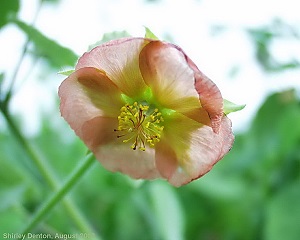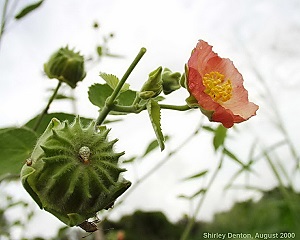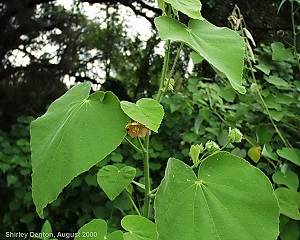|
Abutilon hulseanum
Terciopelo / Mauve
|
Família/Family: Malvaceae
Grupo/Group: Dicotiledónea/Dicotyledon.
Forma de vida/Life form:
Arbusto/Shrub
Forma de vida 2 / Life form 2:
H
Duración de vida/Lifespan:
Perenne/Perennial.
Sustrato/Substrate:
Terrestre/Terrestrial.
Distribución nativa/Native range:
Indias Occidentales (Antillas Menores, Antillas Mayores), sur de Estados Unidos, sur de México, y norte de Centroamérica (Honduras); aparentemente rara en todos los lugares de su distribución excepto Jamaica. / The West Indies (Lesser Antilles, Greater Antilles), southern United States, southern Mexico, and northern Central America (Honduras); apparently rare everywhere in its range except Jamaica.
Mapa de ubicaciones / Map of locations
|
| ESTATUS EN LA ISLA DE PUERTO RICO/STATUS ON THE ISLAND OF PUERTO RICO |
Presencia/Occurence:
Presuntamente extirpado o extinto/Presumed extirpated or extinct.
Origen/Origin:
Nativo/Native.
Historia y distribución/History and distribution:
En matorrales y laderas de cerros en la vecindades de Guánica; rara (Britton & Wilson 1924 [V(3), p. 547], Liogier & Martorell 1982, Liogier 1994 [III, p. 123], Liogier & Martorell, 2000). No se conocen especímenes modernos. Axelrod (2011) excluyó este taxón con base en la falta de especímenes, pero se conocen especímenes de A. commutatum de Puerto Rico, incluyendo el Lectotipo de A. commutatum, colectado por Sintenis en Guánica, en 1886 (3738 NY [NY Specimen ID: 689073]; ILT: P, TEX, US). Este espécimen fue también usado como el Tipo de A. leucophaeum Hochr. Hay una carta de Hochreutiner a Britton de 1923, la cual indica que A. commutatum era el nombre correcto para el espécimen y que A. leucophaeum podría ser un sinónimo de él.
La literatura es inconsistente en cuanto a si A. hulseanum y A. commutatum son distintos, y en cuanto a si el nombre A. commutatum ha sido mal aplicado a A. hulseanum en Puerto Rico. Acevedo-Rodríguez & Strong (2012, 2015) consideran a A. commutatum como sinónimo de A. hulseanum. Otras autoridades (e.g., The Catalogue of Life, The Plant List) consideran A. commutatum como especie distinta, la cual puede estar restringida a Puerto Rico, en cuyo caso A. hulseanum sería un taxón mal aplicado. Axelrod (2011) y USDA PLANTS (2017) consideran A. commutatum como mal aplicado a A. hulseanum en Puerto Rico, pero esto es imposible ya que el espécimen tipo de A. commutatum es de Puerto Rico. A pesar de que es necesario más trabajo, la entidad representada por el espécimen de Sintenis está aparentemente extirpada de Puerto Rico y posiblemente globalmente extinta. Ver también la discusión para A. permolle.
/
In thickets and hillsides in the vicinity of Guanica; rare (Britton & Wilson 1924 [V(3), p. 547], Liogier & Martorell 1982, Liogier 1994 [III, p. 123], Liogier & Martorell, 2000). Britton & Wilson treated this as A. commutatum, which they considered endemic to Puerto Rico. No modern specimens are known. Axelrod (2011) excluded this taxon based on a lack of specimens, but specimens of A. commutatum are known from Puerto Rico, including the Lectotype of A. commutatum collected by Sintenis in Guanica in 1886 (3738 NY [NY Specimen ID: 689073]; ILT: P, TEX, US). This specimen was also used as the type specimen of A. leucophaeum Hochr. There is a letter from Hochreutiner to Britton from 1923, which indicated that A. commutatum was the correct name for the specimen and that A. leucophaeum should be a synonym of it.
The literature is inconsistent concerning whether A. hulseanum and A. commutatum are distinct, and whether the name A. commutatum has been misapplied to A. hulseanum in Puerto Rico. Acevedo-Rodríguez & Strong (2012, 2017) consider A. commutatum to be a synonym of A. hulseanum. Other authorities (e.g., The Catalogue of Life, The Plant List) consider A. commutatum to be a distinct species which may be confined to Puerto Rico, in which case A. hulseanum would be a misapplied taxon. Axelrod (2011) and USDA PLANTS (2017) consider A. commutatum to be misapplied to A. hulseanum in Puerto Rico, but this is impossible since the type specimen of A. commutatum is from Puerto Rico. More work is needed but, regardless, the entity represented by Sintenis’ specimen appears to be extirpated in Puerto Rico and possibly globally extinct. See also the discusion in A. permolle.
|
| CONSERVACIÓN/CONSERVATION |
Global, estatus Lista Roja UICN/IUCN Red List status:
Aún no evaluado, pero en el Catalogue of Life/Not yet assessed, but in the Catalogue of Life.
Puerto Rico, estatus legal DRNA/DNER legal status:
No enlistado/Not listed.
Puerto Rico, lista de rastreo del DRNA 2007/DNER tracking list 2007:
Elemento crítico/Critical element.
Estatus preliminar del IRC para la isla de Puerto Rico (método del NatureServe 2012)/Preliminary IRC status for the island of Puerto Rico (NatureServe 2012 method):
Presuntamente extirpado o extinto/Presumed extirpated or extinct.
Estatus preliminar del IRC para la isla de Puerto Rico (método regional de la Lista Roja de la UICN)/Preliminary IRC status for the island of Puerto Rico (IUCN Red List method):
Extinto en la región/Regionally extinct.
Notas de Conservación/Conservation Notes:
Fue listada por primera vez como especie rara en Puerto Rico por Woodbury et al. (1975), quienes la clasificaron como especie en peligro endémica de Puerto Rico (especie no. 53). Fue enlistada como Elemento Crítico por el DRNA en 1988, 1999 (como En Peligro Crítico) y 2007. Fue incluida como especie de interés global para la conservación por el Center for Plant Conservation en (1992) pero no fue catalogada como en riesgo de extinción debido a datos insuficientes. Fue descrita como una especie conocida de tres o menos localidades en Puerto Rico y las Islas Vírgenes por Figueroa Colon & Woodbury (1996) pero no hay evidencia de que alguno de los autores haya visto alguna planta.
/
This was first listed as a rare species in Puerto Rico by Woodbury et al. (1975), who classified it as an endangered species endemic to Puerto Rico (species no. 53). It was listed as a Critical Element by DNER in 1988, 1999 (as critically imperiled) and 2007. It was included as a species of global conservation concern by the Center for Plant Conservation (1992), but was not ranked as being at risk of extinction due to insufficient data. It was described as a species known from three or fewer locations in Puerto Rico and the Virgin Islands by Figueroa Colon & Woodbury (1996), but there is no evidence either author actually saw any plants.
|
| TAXONOMÍA/TAXONOMY |
Nombre científico con autores/Scientific name with authors:
Abutilon hulseanum
(Torr. & A. Gray) Torr. & A. Gray
Sinónimos/Synonyms:
Abutilon commutatum K. Schum.
|
|
|
ENLACES A PAGINAS EXTERNAS/LINKS TO EXTERNAL WEBSITES
|
|
|
|
Todas las Im�genes/All Images:
|
|
|
|


 Plantas de la Isla de
Plantas de la Isla de












